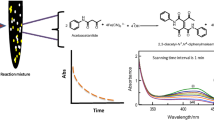Conclusions
-
1.
The kinetic principles of the hydrolysis of d-cellobiose were investigated in a broad range of temperatures and H2SO4 concentrations by a polarimetric method.
-
2.
In H2SO4 solutions, the concentration of which is below 50%, the hydrolysis product of d-cellobiose-d-glucose is stable (it is the final product). When the concentration of the H2SO4 solution is more than 50%, d-glucose undergoes complex chemical conversions in the solution.
-
3.
A scheme of the process is proposed, according to which cellobiose is hydrolyzed to glucose; the latter is converted to an intermediate optically active product, which then decomposes to optically inactive substances.
-
4.
The rate constants of the hydrolysis of cellobiose were calculated with an analog computer.
-
5.
The effective rate constants of the hydrolysis of cellobiose are described by an equation corresponding both to bi- and to monomolecular mechanisms.
Similar content being viewed by others
Literature cited
N. A. Khalturinskii, Yu. V. Moiseev, G. E. Zaikov, V. S. Marevtsev, and G. A. Kogan, Izv. Akad. Nauk SSSR, Ser. Khim., 1785 (1970).
N. A. Khalturinskii, Yu. V. Moiseev, and G. E. Zaikov, Izv. Akad. Nauk SSSR, Ser. Khim., 2686 (1970).
K. Freudenberg and W. Kuhn, Ber.,68, 2070 (1935).
K. Freudenberg and W. Kuhn, Ber.,63, 1510 (1930).
G. N. La Diega, Chemica et Industria,41, 5 (1959).
R. Senju, J. Agric. Chem. Soc., Japan,25, 227 (1951–1952).
Z. A. Rogovin and A. A. Konkin, Reports of the Seventh Conference on High-Molecular Compounds [in Russian], Izd-vo AN SSSR (1952), p. 140.
A. Meller, J. Polymer Sci.,2, 1024 (1964).
L. I. Novikova and A. A. Konkin, Zh. Prikl. Khim.,32, 1105 (1959).
Mary L. Nelson, J. Polymer Sci.,43, 351 (1960).
A. Sharpless, Trans. Faraday Soc.53, 1003 (1957).
E. Kalges, Liebigs. Ann. Chem.,520, 71 (1935).
R. Senju and M. Shimzu, J. Agric. Chem. Soc., Japan,25, 231 (1951).
M. I. Vinnik, Uspekhi Khimii,35, 1922 (1966).
The Chemist's Handbook [in Russian], Vol. 3, Khimiya, Moscow-Leningrad (1964), p. 333.
M. I. Vinnik, I. M. Medvedskaya, L. R. Andreeva, and A. E. Tiger, Zh. Fiz. Khimii,41, 252 (1967).
C. A. Bunton and I. B. Ley, J. Chem. Soc., 2327 (1957).
Author information
Authors and Affiliations
Additional information
Translated from Izvestiya Akademii Nauk SSSR, Seriya Khimicheskaya, No. 12, pp. 2664–2671, December, 1971.
The authors are grateful to N. M. Émanuél' for his interest in the work and to M. Brin for his aid in the work on the analog computer.
Rights and permissions
About this article
Cite this article
Khalturinskii, N.A., Moiseev, Y.V., Vinnik, M.I. et al. Mechanism of the destruction of polyacetals in solutions of acids. Russ Chem Bull 20, 2530–2535 (1971). https://doi.org/10.1007/BF00853617
Received:
Issue Date:
DOI: https://doi.org/10.1007/BF00853617



